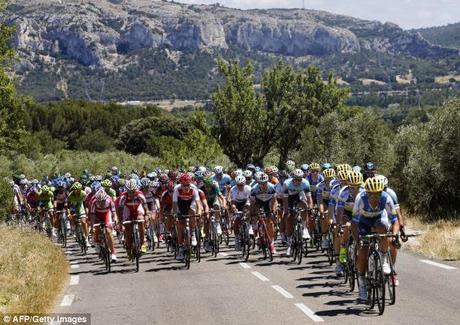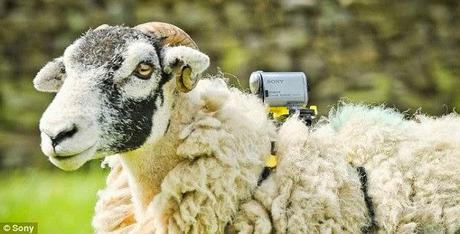 The Tour de France, is an annual multiple stage bicycle
race primarily held in France, while also occasionally making passes through
nearby countries. The race was first organized in 1903 to increase paper sales for the magazine
L'Auto; it is currently run by the Amaury Sport Organisation. As the Tour gained prominence and popularity
the race was lengthened and its reach began to extend around the globe. Though there are some other races too, the
Tour is the oldest and generally considered the most prestigious. Traditionally, the race is held primarily in
the month of July. While the route changes each year, the format of the race
stays the same with the appearance of at least two time trials, the passage
through the mountain chains of the Pyrenees and the Alps, and the finish on the
Champs-Élysées in Paris. The modern
editions of the Tour de France consist of 21 day-long segments (stages) over a
23-day period and cover around 3,500 kilometres (2,200 mi).
Daily Mail reports of the technology which provides
‘ewe-nique’ view of the Tour de France.
Wonder what ? - Sheep are fitted
with ‘action cameras’ to record cyclists as they pass by fields…. ..the article
in Daily Mail states that as 198 cyclists begin the gruelling 118-mile (190km)
trip across the UK and into France, the first stages will be recorded by an
unlikely source - sheep. A total of five ‘sheepcams’ will film the bikes as
they pass through Yorkshire town, and the cameras will be controlled remotely
by farmer Ian Hammond. Each of the animals from Harewell Hall have been fitted
with wearable action cameras from Sony. They are waterproof, include image
stabilisation and all five can be controlled at one time with a single remote.
The Tour de France, is an annual multiple stage bicycle
race primarily held in France, while also occasionally making passes through
nearby countries. The race was first organized in 1903 to increase paper sales for the magazine
L'Auto; it is currently run by the Amaury Sport Organisation. As the Tour gained prominence and popularity
the race was lengthened and its reach began to extend around the globe. Though there are some other races too, the
Tour is the oldest and generally considered the most prestigious. Traditionally, the race is held primarily in
the month of July. While the route changes each year, the format of the race
stays the same with the appearance of at least two time trials, the passage
through the mountain chains of the Pyrenees and the Alps, and the finish on the
Champs-Élysées in Paris. The modern
editions of the Tour de France consist of 21 day-long segments (stages) over a
23-day period and cover around 3,500 kilometres (2,200 mi).
Daily Mail reports of the technology which provides
‘ewe-nique’ view of the Tour de France.
Wonder what ? - Sheep are fitted
with ‘action cameras’ to record cyclists as they pass by fields…. ..the article
in Daily Mail states that as 198 cyclists begin the gruelling 118-mile (190km)
trip across the UK and into France, the first stages will be recorded by an
unlikely source - sheep. A total of five ‘sheepcams’ will film the bikes as
they pass through Yorkshire town, and the cameras will be controlled remotely
by farmer Ian Hammond. Each of the animals from Harewell Hall have been fitted
with wearable action cameras from Sony. They are waterproof, include image
stabilisation and all five can be controlled at one time with a single remote.
 Ian Hammond said: ‘Locally we are really looking forward
to the Tour de France coming through Yorkshire, the dales certainly are a good
test for cyclists and I’m looking forward to seeing how my flock perform as
Sony’s first ever sheep cam’. Earlier, German entrant Marcel Kittel, 26, warned
Yorkshire's roads could be too narrow for the Tour de France. He said the
winding streets, enclosed by dry stone walls, were 'risky' for riders taking
part in the opening stages.
The event, won last year by Britain's Chris Froome, often
includes technically challenging routes, including mountain climbs, narrow
streets and cobbled surfaces. A spokesman for Yorkshire's Grand Départ defended
the region's roads as testing, but suitable, for the world's best riders.
Ian Hammond said: ‘Locally we are really looking forward
to the Tour de France coming through Yorkshire, the dales certainly are a good
test for cyclists and I’m looking forward to seeing how my flock perform as
Sony’s first ever sheep cam’. Earlier, German entrant Marcel Kittel, 26, warned
Yorkshire's roads could be too narrow for the Tour de France. He said the
winding streets, enclosed by dry stone walls, were 'risky' for riders taking
part in the opening stages.
The event, won last year by Britain's Chris Froome, often
includes technically challenging routes, including mountain climbs, narrow
streets and cobbled surfaces. A spokesman for Yorkshire's Grand Départ defended
the region's roads as testing, but suitable, for the world's best riders.
 And anything on Cycline / Tour de France would be
incomplete without reference to Armstrong.
Lance Edward Armstrong won the
Tour de France a record seven consecutive times between 1999 and 2005 before he
was disqualified from all those races and banned from competitive cycling for
life, for doping offenses by the Union Cycliste Internationale (UCI) in 2012,
after the United States Anti-Doping Agency (USADA) presented its findings. A
cancer survivor, he is the founder of the Livestrong Foundation, originally
called the Lance Armstrong Foundation, which provides support for cancer
patients.
At age 16, Armstrong began competing as a triathlete and
was a national sprint-course triathlon champion in 1989 and 1990. In 1992,
Armstrong began his career as a professional cyclist with the Motorola team. In
October 1996, he was diagnosed with testicular cancer that had spread to his
brain, lungs and abdomen. His cancer treatments included brain and testicular
surgery and extensive chemotherapy. In February 1997, he was declared
cancer-free and the same year he founded the Lance Armstrong Foundation. In Feb 2011, Armstrong announced his
retirement from competitive cycling. In
Aug 2012, a life time ban was issued and the Sports Organising body USADA which also stripped Armstrong of his
seven Tour de France titles.
Though he got into controversies, one feels somehow to support him for his strongminded recovery and the public activities that he is involved in .....
With regards – S. Sampathkumar.
7th July 2014.
And anything on Cycline / Tour de France would be
incomplete without reference to Armstrong.
Lance Edward Armstrong won the
Tour de France a record seven consecutive times between 1999 and 2005 before he
was disqualified from all those races and banned from competitive cycling for
life, for doping offenses by the Union Cycliste Internationale (UCI) in 2012,
after the United States Anti-Doping Agency (USADA) presented its findings. A
cancer survivor, he is the founder of the Livestrong Foundation, originally
called the Lance Armstrong Foundation, which provides support for cancer
patients.
At age 16, Armstrong began competing as a triathlete and
was a national sprint-course triathlon champion in 1989 and 1990. In 1992,
Armstrong began his career as a professional cyclist with the Motorola team. In
October 1996, he was diagnosed with testicular cancer that had spread to his
brain, lungs and abdomen. His cancer treatments included brain and testicular
surgery and extensive chemotherapy. In February 1997, he was declared
cancer-free and the same year he founded the Lance Armstrong Foundation. In Feb 2011, Armstrong announced his
retirement from competitive cycling. In
Aug 2012, a life time ban was issued and the Sports Organising body USADA which also stripped Armstrong of his
seven Tour de France titles.
Though he got into controversies, one feels somehow to support him for his strongminded recovery and the public activities that he is involved in .....
With regards – S. Sampathkumar.
7th July 2014.
Photo credits : dailymail.co.uk

